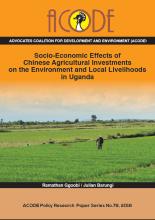Land Library
Welcome to the Land Portal Library. Explore our vast collection of open-access resources (over 74,000) including reports, journal articles, research papers, peer-reviewed publications, legal documents, videos and much more.
/ library resources
Showing items 1 through 9 of 9.The need to establish the link between land tenure and food security is increasingly gaining currency as governments and development organizations refocus their effort towards assisting farmers to move away from subsistence farming to commercial agriculture.
The nature and significance of China's engagements with African agriculture continues to be hotly debated in the media, academia and policy circles around the world.
In Senegal, concern about large-scale land acquisitions has been growing since 2000. Senegalese agriculture has long relied on small-scale family holdings and extensive agriculture.
Pastoralists have a unique relationship of mutual dependency with their livestock and their environment; the uniqueness of this relationship distinguishes them from other livestock keepers.
This rangelands management framework is a product of a rapid pastoralist-led rangeland health assessment that was conducted in three sampled districts of Karamoja; Moroto, Napak and Kotido.
Excluding the introductory and concluding chapters, this book has 11 chapters presented in three sections. The first section dwells primarily on conceptual issues, which comprehensively unravels large-scale agricultural investments and their impacts at the theoretical level.
This paper explores, conceptually and empirically, the question of how much food is produced by women. Data for labour inputs and agricultural output are used to assess women’s contribution to food and agricultural production. The study also assesses gender differences in productivity.
In 1991, Terminology for Grazing Lands and Grazing Animals was published with the objective of ‘developing a consensus of clear definitions of terms used in the grazing of animals.’ This first effort involved primarily organizations and agencies within the USA but included representation from New
In the developed countries less than 20 per cent of the population is engaged in agriculture. The rest is employed in the industrial sector. In the underdeveloped countries less than 10 per cent of the population is employed in the industrial sector and the rest is engaged in agriculture.








